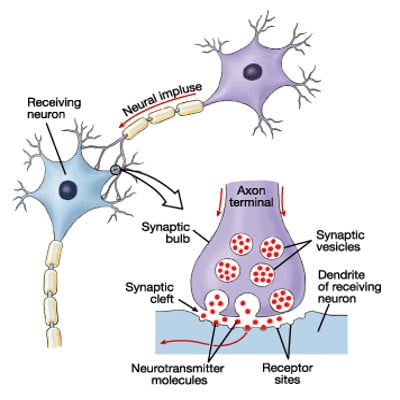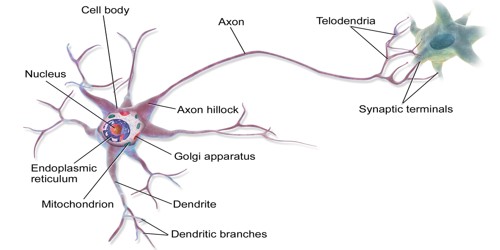Neurotransmitters are chemical messengers. They are the molecules used by the nervous system to transmit messages between neurons, or neurons to muscles. Their job is to transmit signals from nerve cells to target cells. They send information between neurons by crossing a synapse. It influences a neuron in one of three ways: excitatory, inhibitory or modulatory. Electrical signals are not able to cross the gap between most neurons. They are changed into chemical signals to cross the gap. Once they reach the next neuron they are absorbed. The neuron then changes this chemical signal back into an electrical signal called an action potential. The action potential passes across the next neuron and to the next synapse. Whether a neurotransmitter is excitatory or inhibitory depends on the receptor it binds to. After neurotransmitters deliver their messages, the body breaks down or recycles them.
Most neurotransmitters are either small amine molecules, amino acids, or neuropeptides. Many of them are made from amino acids, which are part of your diet and it takes only a few steps to convert them. Neurotransmitters play a major role in shaping everyday life and functions. These chemicals and their interactions are involved in countless functions of the nervous system as well as controlling bodily functions. Scientists do not yet know exactly how many neurotransmitters exist, but more than 100 chemical messengers have been identified.

Each neurotransmitter has a different function. For example, dopamine is used in reward and pleasure and noradrenaline is used in an animal’s “fight or flight” response. Neurotransmitters also regulate the passing of messages. These chemical messengers can affect a wide variety of both physical and psychological functions including heart rate, sleep, appetite, mood, and fear.
The human brain contains an estimated 86 billion neurons. The brain needs neurotransmitters to regulate many necessary functions, including: heart rate, breathing, sleep cycles, digestion, concentration, appetite, etc.
The most common transmitter is glutamate, which is excitatory at well over 90% of the synapses in the human brain. The next most prevalent is called GABA, which inhibits at more than 90% of the synapses that do not use glutamate. Glutamate is the main excitatory transmitter in the central nervous system. GABA is the main inhibitory neurotransmitter in the adult vertebrate brain. When neurotransmitters are affected by disease or drugs, there can be a number of different adverse effects on the body.
Neurotransmitters are transported within neurons by small “sacks” called vesicles. When these vesicles come into contact with the neuron’s cell membrane, it opens. This releases the neurotransmitters into the synaptic cleft.
















